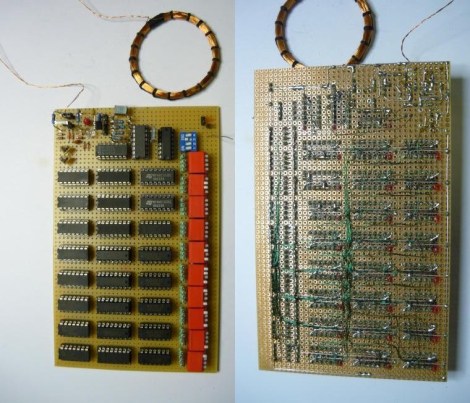
This soldering nightmare is a configurable RFID tag which has been built from 7400-series logic chips. The beast of a project results in an iPhone-sized module which can be used as your new access card for security systems that uses the 125 kHz tags. The best part is that a series of switches makes the tag hand programmable, albeit in binary.
Of course this is an entry in this year’s 7400 Logic Competition. It’s from last year’s winner, and he’s spent a lot of time documenting the project; which we love. We were surprised that this many chips can be powered simply by what is induced in the coil from the reader. This is just one of the reasons the 7400-series have been so popular over the years. After working out the numbers, a 64-bit shift register was built to feed the tag ID to the encoding portion of the design. There were many kinks to work out along the way, but once it was functional a surface-mount design was put together resulting in the final product shown off in the video after the break.
















>>We were surprised that this many chips can be powered simply by what is induced in the coil from the reader.
>>This is just one of the reasons the 7400-series have been so popular over the years
These are relatively modern CMOS 74HCxx series chips, they use low power if you don’t clock them fast.
The true “original” 74xx would probably be a different story.
A different story indeed!
The VAX 11/750 (a washing-machine sized “minicomputer” from the late 70s / early 80s) consisted of logic chips and gate arrays. I don’t know if it used the 7400 series, but I think its chips are probably comparable.
They sure did need a lot of power. The 11/750 has a 135A 5V supply and an 85A 2.5V supply. That’s a lot of current!
2.5V supply? That sounds like ECL chips, they were fast, but really power hungry. Much more so, than TTL chips.
agreed(was mentioned in article),
but im still amazed that they powered all those chips from a regular EM transmission, even with CMOS/HC…
whats the distance?
PS: the old 7400 chips, the TTL ones … 1ma on input to register a bit,,, the powersupply requirement would be more then this not counting the inputs’s current. but with the new CMOS/HC, much MUCH less powersupply per chip and the inputs work with virtually no load on inputs
The distance if from tight on the reader to about 4..5cm.
It depends on which reader I test and the exact position of the coils with respect to each other.
B^)
brilliant
Congratulations on getting the thing working, it’s an elegant design and the documentation is a great resource for anyone who want to understand how these 125 kHz RFID tags work.
Fantastic build. Truly impressive electronic engineering/hacking here.
Any bets on something like this showing up in a TV show or movie in the near future?
They did not contact me yet ;-)
indeed impressive, well done.
There’s something about a load of chips on a board that I find so alluring~
Cool retro-rfid card. Big as my old cell phone :P
http://h30434.www3.hp.com/t5/image/serverpage/image-id/10157iFEB9C93D5FC0E3D6/image-size/original?v=mpbl-1&px=-1
When I read 7400 chips, I thought ‘Wow, that’s a lot of ICs…’
I’m an idiot.
This is very cool though.
This may sound silly, but what exactly is the difference between RFID and NFC?
Your next assignment, should you decide to accept it, is to build a Core 7 Intel CPU with 7400 NAND gates. I’m sure they’re cheaper by the truckload :)